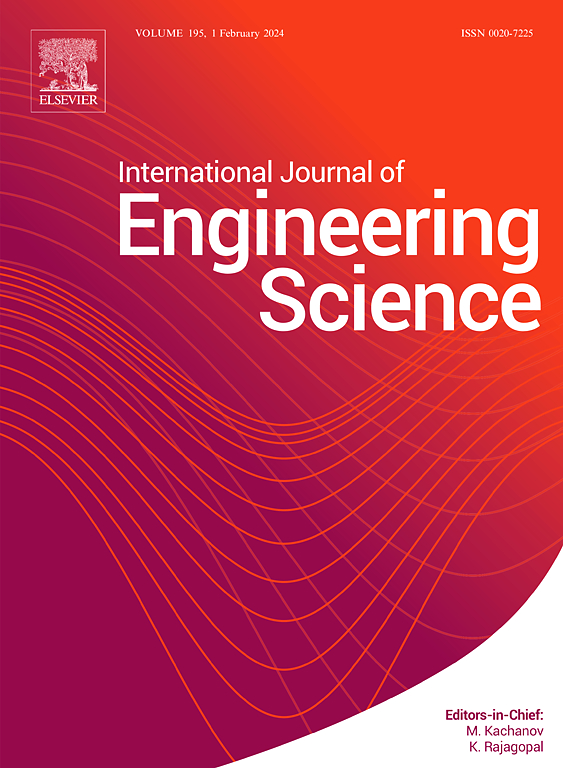Numerical modeling of effective elastic properties for heterogeneous porous media. Application to a case study of a carbonate reservoir rock sample
IF 5.7
1区 工程技术
Q1 ENGINEERING, MULTIDISCIPLINARY
International Journal of Engineering Science
Pub Date : 2025-06-20
DOI:10.1016/j.ijengsci.2025.104309
引用次数: 0
Abstract
An application of an open-access software destined for fast calculation of the contribution of an individual inhomogeneity of one of two types (cracks or inclusions/pores) to calculation of the effective elastic properties of an oil reservoir rock sample extracted from a wellcore fragment containing isolated pores is presented. We obtained the pore geometries by a 3D image from an X-ray tomography processed and converted into stereolithography (.stl) format. The data required for the calculations besides the shapes of the inhomogeneities are the Young’s modulus and the Poisson’s ratio of the matrix (in the isotropic case); these data were found by geological analysis. After we had calculated the contribution of each pore to the elastic properties of the rock sample, we obtained the overall effective elastic properties by the Mori–Tanaka scheme. The proposed methodology is straightforward and it was possible to detect even a slight anisotropy (less than 5%) of the effective elastic properties. We found experimentally the effective elastic properties of the sample from the measurement of the acoustic wave velocities. The results obtained show a good agreement in terms of anisotropy and porosity detection; however, the effective elastic properties diverged by a large margin (up to 200%). This may be explained by the presence of microcracks undetected by the tomography. As a future work, we consider a more thorough study of the microstructure of the sample to verify the hypothesis about the presence of microcracks.
非均质多孔介质有效弹性特性的数值模拟。应用于碳酸盐岩储层岩石样品的实例研究
本文介绍了一种开放获取软件的应用,该软件旨在快速计算两种类型(裂缝或包裹体/孔隙)中的一种的单个不均匀性对计算从含有孤立孔隙的井心碎片中提取的油藏岩石样品的有效弹性特性的贡献。我们通过处理并转换为立体光刻(.stl)格式的x射线断层扫描3D图像获得孔隙几何形状。除了非均匀性的形状外,计算所需的数据是矩阵的杨氏模量和泊松比(在各向同性的情况下);这些资料是通过地质分析发现的。在计算了各孔隙对岩样弹性特性的贡献后,采用Mori-Tanaka方案得到了岩样整体有效弹性特性。所提出的方法很简单,甚至可以检测到有效弹性特性的轻微各向异性(小于5%)。通过对声波速度的测量,实验发现了试样的有效弹性特性。所得结果在各向异性和孔隙度检测方面具有较好的一致性;然而,有效弹性性能差异很大(高达200%)。这可以用断层扫描未检测到的微裂纹的存在来解释。作为未来的工作,我们考虑对样品的微观结构进行更深入的研究,以验证关于微裂纹存在的假设。
本文章由计算机程序翻译,如有差异,请以英文原文为准。
求助全文
约1分钟内获得全文
求助全文
来源期刊

International Journal of Engineering Science
工程技术-工程:综合
CiteScore
11.80
自引率
16.70%
发文量
86
审稿时长
45 days
期刊介绍:
The International Journal of Engineering Science is not limited to a specific aspect of science and engineering but is instead devoted to a wide range of subfields in the engineering sciences. While it encourages a broad spectrum of contribution in the engineering sciences, its core interest lies in issues concerning material modeling and response. Articles of interdisciplinary nature are particularly welcome.
The primary goal of the new editors is to maintain high quality of publications. There will be a commitment to expediting the time taken for the publication of the papers. The articles that are sent for reviews will have names of the authors deleted with a view towards enhancing the objectivity and fairness of the review process.
Articles that are devoted to the purely mathematical aspects without a discussion of the physical implications of the results or the consideration of specific examples are discouraged. Articles concerning material science should not be limited merely to a description and recording of observations but should contain theoretical or quantitative discussion of the results.
 求助内容:
求助内容: 应助结果提醒方式:
应助结果提醒方式:


